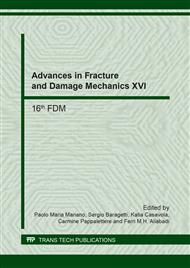[1]
M.H. Aliabadi, The boundary element method: applications in solids and structures, (John Wiley & Sons Ltd, England, 2002).
Google Scholar
[2]
G.K. Sfantos & M.H. Aliabadi, A boundary cohesive grain element formulation for modelling intergranular microfracture in polycrystalline brittle materials. International Journal of Numerical Methods in Engineering, Vol. 69(8) (2007), pp.1590-1626.
DOI: 10.1002/nme.1831
Google Scholar
[3]
G.K. Sfantos & M.H. Aliabadi, Multi-scale boundary element modelling of material degradation and fracture. Computer Methods in Applied Mechanics and Engineering, Vol. 196(7) (2007), pp.1310-1329.
DOI: 10.1016/j.cma.2006.09.004
Google Scholar
[4]
I. Benedetti & M.H. Aliabadi, A three-dimensional grain boundary formulation for microstructural modeling of polycrystalline materials. Computational Materials Science, Vol. 67 (2013), pp.249-260.
DOI: 10.1016/j.commatsci.2012.08.006
Google Scholar
[5]
I. Benedetti & M.H. Aliabadi, A three-dimensional cohesive-frictional grain-boundary micromechanical model for intergranular degradation and failure in polycrystalline materials. Computer Methods in Applied Mechanics and Engineering, Vol. 265 (2013).
DOI: 10.1016/j.cma.2013.05.023
Google Scholar
[6]
I. Benedetti & M.H. Aliabadi, Multiscale modeling of polycrystalline materials: A boundary element approach to material degradation and fracture. Computer Methods in Applied Mechanics and Engineering, Vol. 289 (2014), pp.429-453.
DOI: 10.1016/j.cma.2015.02.018
Google Scholar
[7]
V. Gulizzi, A. Milazzo & I. Benedetti, An enhanced grain-boundary framework for computational homogenization and micro-cracking simulations of polycrystalline materials. Computational Mechanics, Vol. 56(4) (2015), pp.631-651.
DOI: 10.1007/s00466-015-1192-8
Google Scholar
[8]
V. Gulizzi, A. Milazzo & I. Benedetti, Fundamental solutions for general anisotropic multi-field materials based on spherical harmonics expansions. International Journal of Solids and Structures, Vol. 100 (2016), pp.169-186.
DOI: 10.1016/j.ijsolstr.2016.08.014
Google Scholar
[9]
J.D. Clayton and J. Knap. Phase field modeling of directional fracture in anisotropic polycrystals. Computational Materials Science, Vol. 98 (2015), pp.158-169.
DOI: 10.1016/j.commatsci.2014.11.009
Google Scholar
[10]
I. Benedetti, V. Gulizzi & V. Mallardo, A grain boundary formulation for crystal plasticity. International Journal of Plasticity, Vol. 83 (2016), pp.202-224.
DOI: 10.1016/j.ijplas.2016.04.010
Google Scholar


